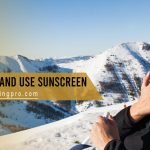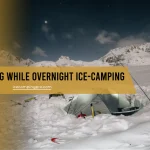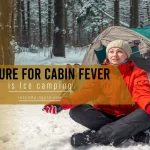Are you preparing for ice camping? Do you need clarification as to what kind of sunscreen would adequately protect you from UV radiation from the sun? This post is for you if you answered yes to any of the preceding questions. When preparing for ice camping, it is critical to choose and use sunscreen to protect your skin from the searing sun for the majority of the time.
Excess exposure to the sun’s rays harms the skin, causing premature aging, discoloration, and wrinkles. Many individuals choose and use sunscreen on sunny days or when they are outside for an extended time. On the other hand, dermatologists urge using sunscreen regularly, arguing that even indoors, UV radiation from the sun can permeate the windows and doors.
Why is Sunscreen Important for Ice Camping
Many people regard ice camping as a means to connect with the natural environment, and they plan trips to Antarctica and other isolated locations on Earth. Since ice camping is an outdoor activity, sunscreen is vital for preventing sunburns. Also, Doctors have determined that excessive sun exposure can cause blistering or even skin cancer, the most common type today. The high cases of skin cancer today are because many individuals take for granted care for their skin, especially against UV rays from the sun.
Furthermore, like water, ice reflects the sun’s rays, increasing their strength and your risk of skin injury. Also, because of the steady wind speed and lower humidity, you will find that your skin is more dried out during cold weather. Hence, the need for sunscreen while ice camping is paramount.
Choosing Sunscreen for Ice Camping
Numerous sunscreens are available today; however, you should be extremely cautious while selecting a sunscreen. Choose and use sunscreen includes reading its label and comprehending its chemical composition. Understanding its composition will allow you to identify its broad-spectrum SPF value, water resistance, and the presence of mineral or chemical ingredients. Furthermore, depending on how sensitive your skin is, reading the label will help you choose between oxybenzone and avobenzone-based sunscreens.
What to Look for in a Sunscreen for Ice Camping
Many people are still determining what to look for when selecting sunscreen for themselves. They frequently compare one sunscreen to another or their pricing without paying attention to the essential information that should guide their decisions. We will now go through the primary aspects that should influence your sunscreen selection.
Look for broad-spectrum sunscreens, which offer protection against UVA and UVB radiation, which cause aging and sunburns. Please take note of its sun protection factor (SPF), which physicians recommend should be 30 or above. You should be aware of your skin type. Doctors prescribe non-comedogenic sunscreens for persons with oily skin because they do not clog pores. Sunscreens with hydrating components such as hyaluronic acid, glycerin, or ceramides are suitable for persons with normal or dry skin.
Additionally, if you have sensitive skin, you should avoid products that contain chemical ingredients because they can be harsh on the skin. Dermatologists advocate sunscreens containing zinc oxide or titanium dioxide since these minerals are non-irritating to the skin.
Types of Sunscreens for Ice Camping
The two major types of sunscreens for ice camping are physical and chemical. Although both provide equivalent protection, their use is by personal preference. Physical sunscreens sit on the skin and repel UV rays, whereas chemical sunscreens help the skin absorb UV radiation and convert them to energy. Physical sunscreens, often mineral sunscreens, protect the skin despite leaving a whitish cast. Chemical sunscreens, on the other hand, are absorbed into the skin; they absorb the sun’s rays and convert them to heat. This absorption into the skin is why they are applied at least 30 minutes before going outside.
Powder sunscreen is a type of sunscreen that is both physical and mineral-based, yet it does not leave a whitish cast. Powder sunscreen is an option for those who dislike the greasy feeling of using lotions.
Using Sunscreen for Ice Camping
We’ve demonstrated that using sunscreen while ice camping is critical because it protects your skin from exposure to the sun’s UV rays. Aside from applying sunscreen, there are other strategies to improve sun protection while ice camping.
How much sunscreen to apply
Dermatologists advise using enough sunscreen to cover the entire body, especially in places not covered by clothing. Apply sunscreen to all exposed body regions, including ears, hands, shoulders, back, knees, and legs. For the lotion types of sunscreens, you should shake them well before use. You should also apply sunscreens liberally but be cautious around the eyes. If you only have a spray sunscreen, spray it into your palms, then use your palms for even application.
When to reapply sunscreen
Reapplying sunscreen during the day is critical because a single application will not protect you throughout the day. Experts recommend reapplying sunscreen every two hours if you are in the sun. Although some sunscreens are water-resistant, experts advise reapplying promptly after swimming or anything after anything that causes you to sweat. Even if you are wearing protective clothes or indoors, experts have proven that UV rays from the sun can still penetrate. Thus, you must reapply sunscreen and protect yourself.
The other ways you can protect your skin from the sun
Wearing sunscreen does not imply saying, ‘Bring it on, sunlight!’ Sun-protective clothing, such as headwear, caps, hand gloves, and sunglasses, should be worn, especially when working outside. Wear something to cover your hands and legs, and choose clothing with UV protection. Athleta is a sun-protective fabric with a UPF of up to 50, which makes it effective in blocking the rays from the sun. REI and Coolibar are also suitable sun-protective fabrics that offer good UV ray protection; these outfits come in a variety of styles; it all depends on personal preferences.
How to stay safe in the sun while ice camping
When going ice camping, you should bring tents in addition to protective equipment because these tents give shade from the sun’s UV rays. Another tip is to stay hydrated; drink water even if you don’t feel thirsty. Please try to find shade and stay under it whenever possible; tagging along an umbrella is also a good idea. Also, wear your sunglasses always to protect your eyes from UV rays from the sun.
Best Sunscreen for Ice Camping – Our Top Picks
Neutrogena Sunscreen
Dr. Joshua Zeichner, MD of cosmetic and clinical research at Mount Sinai Hospital’s dermatology department, has publicly said that his preferred sunscreen is Neutrogena Sunscreen. Dr. Zeichner suggests a higher SPF number and advises users to reapply frequently for the best UV protection.
Pros and cons
Neutrogena sunscreen is dermatologist-tested, water-resistant, and has a broad spectrum. It offers up to five times the shade protection and does not leave a whitish cast.
Neutrogena is a non-comedogenic sunscreen, meaning it does not clog pores, which is ideal for all skin types. Furthermore, Neutrogena comes in various packs and sizes, has an SPF of up to 50, and is widely available.
On the other hand, Neutrogena sunscreen contains parabens, a preservative chemical that causes skin irritation. Another disadvantage is that individuals have claimed the price needs to be lowered compared to other sunscreens.
What makes Neutrogena sunscreen so unique?
Neutrogena sunscreen offers an oil-free and perspiration-free appearance and does not wash away with sweat; nonetheless, it must be reapplied every two hours, just like any other sunscreen. For most people, Neutrogena sunscreen is creamy and moisturizing and thus does not require additional moisturizer.
Dimensions: 3 Ounces
Weight: 0.5 Pounds
Capacity: 6 Fl Oz
Banana Boat Sunscreen
Banana Boat Sunscreen is a highly effective sunscreen that lasts long. Banana Boat sunscreen is top-rated among athletes and anyone who enjoys outdoor sports because it can last up to two hours before reapplication. This sunscreen is odorless, lightweight, and scientifically proven to protect against UVA and UVB radiation.
Pros and cons
Some customers appreciate that Banana Boat Sunscreen spreads little; moreover, those who prefer sunscreens that spread widely consider this a disadvantage. The skin absorbs Banana Boat Sunscreen quickly and does not appear oily; nonetheless, it becomes whiter until entirely absorbed. Also, plenty is required to cover the entire body.
What distinguishes Banana Boat sunscreen?
Except for the lip balm sunscreen, SPF 30+, Banana Boat sunscreens are all SPF 50+, with some even reaching SPF 100. They are made to survive lengthy sweating and are water resistant for up to four hours, though dermatologists recommend reapplying every two hours.
Dimensions: 8 Ounces
Weight: 0.82 Pounds
Capacity: 12 Fl Oz
Coppertone Sunscreen
Coppertone Sunscreen made CNN’s list of the top sunscreens for 2023. It provides safe protection and is easy to apply. It is lightweight, vitamin E-rich, and water-resistant, making it ideal for swimmers. Coppertone Sunscreen has a light chemical aroma that quickly diffuses and dissipates and, as such, poses no trouble to users.
Pros and cons
Coppertone Sunscreen is SPF 50, broad-spectrum, and odorless. Coppertone Sunscreen is water resistant, contains solely zinc oxide, and applies smoothly to the skin. However, People have noted that its waxy quality makes it difficult to wear because you must spend time applying it to your skin. Another disadvantage is that it leaves a prominent white cast on the skin.
What differentiates Coppertone sunscreen?
The fact that Coppertone Sunscreen is a physical sunscreen with a broad spectrum is fantastic. It contains only zinc oxide as an active ingredient and no oxybenzone, aminobenzoic acid, or trolamine salicylate, which dermatologists say is unsafe. A Coppertone sunscreen is an attractive option to avoid chemical sunscreens.
Dimensions: 6.9 Ounces
Weight: 1.12 Pounds
Capacity: 14 Fl Oz
Aveeno Sunscreen
Aveeno Sunscreen is a broad-spectrum sunscreen with SPF 60 that moisturizes the skin. Made with prebiotic oat, it is lightweight and leaves the skin feeling hydrated and nutritious. Aveeno Sunscreen protects against UVA and UVB solar radiation and skin ageing. It is a non-comedogenic sunscreen essential for outdoor activities like ice camping.
Pros and cons
Aveeno Sunscreen is free of parabens, phthalates, oil, oxybenzone, and dyes, making it suitable for sensitive skin. It is water and sweat resistant and can last for up to 80 minutes before needing to be reapplied. It does not leave a white cast and dries rapidly, making it suitable for use under makeup. However, some customers have complained that it is thin and needs reapplication frequently.
What makes Aveeno sunscreen so unique?
Aveeno Sunscreen has a UV protection factor of up to 60, is easy to apply, and does not leave a white cast. Oats are employed as significant ingredients in manufacturing because of their anti-oxidizing properties and ability to soothe and moisturize the skin. Because of its anti-inflammatory properties, oat also helps to protect the skin from harm by preventing the growth of infections.
Dimensions: 2.0 Ounces
Weight: 0.23 Pounds
Capacity: 3 Fl Oz
Australian Gold Sunscreen
Australian Gold Sunscreen Lotion comes in SPF 30 and 50. It is lightweight, water-resistant, and easy to use. Australian Gold Sunscreen provides excellent UVA and UVB light protection while nourishing your skin.
Pros and cons
Australian Gold Sunscreen Lotion is a non-chemical sunscreen that refreshes and moisturizes the skin. It is carefully formulated for sensitive skin and does not clog pores or emit odour. Although Australian Gold Sunscreen is high in vitamin E, it leaves a white cast on the skin.
What makes Australian Gold sunscreen unique?
Australian Gold sunscreen contains green tea extracts, Aloe Vera, vitamin E, sunflower seed extracts, and tea tree oil. These nutrients keep your skin moisturized and young-looking.
Dimensions: 3 Ounces
Weight: 0.52 Pounds
Capacity: 8.01 Fl Oz
Sun Bum Sunscreen
Sun Bum Sunscreen is a face lotion sunscreen with SPF 50 that is fragrance-free and effective against UV radiation. It contains vitamin E, nourishes the skin, and is water- and sweat-proof, making it an excellent choice for swimming or ice camping. Sun Bum is non-comedogenic sunscreen dermatologists recommend using 15 minutes before going outside and reapplying every 2 hours if swimming or sweating.
Pros and cons
Sun Bum Sunscreen is paraben-free and hence safe for all skin types. It is also lightweight and portable. Sun Bum sunscreen contains a broad spectrum, is soft to the touch, and is easy to apply to the body and face. It’s thick yet not oily. Some users, however, have reported that Sun Bum sunscreen has no tanning ingredient.
What makes Sun Bum sunscreen so special?
Sun Bum Sunscreen contains aloe vera, making it gentle on the skin and not irritating even to the skin around the eyes. Also, it does not leave a white cast behind.
Dimensions: 3 Ounces
Weight: 0.24 Pounds
Capacity: 3 Fl Oz
Badger Sunscreen
Badger Sunscreen is a sunscreen produced by Badger, a firm noted for producing skin care products from organic raw materials. Badger sunscreen comprises 98 per cent organic components with an SPF of 40. It is widely available and reasonably priced, provides adequate protection against the sun’s UVA and UVB radiation and is very suitable for ice camping. Exotic oils, beeswax, and plant extracts rich in organic compounds are among the ingredients in Badger sunscreen.
Pros and cons
Badger Sunscreen is a physical sunscreen with zinc oxide as its main ingredient and is thus suitable for persons with sensitive skin. Whereas traditional sunscreens are water-based, Badger sunscreen is made with sunflower oil and does not create a white cast. However, the sunscreen is not a cream; you must exert some effort to apply it all over your body.
What distinguishes Badger Sunscreen?
Badger sunscreen contains four primary ingredients: zinc oxide, sunflower oil, beeswax, and vitamin E, which nourish and protect the skin from UV rays. It has predominantly organic and sustainable components and comes in a recyclable tin container.
Dimensions: 3.84 Ounces
Weight: 0.15 Pounds
Capacity: 2.94 Fl Oz
Blue Lizard Sunscreen
Blue Lizard sunscreen has an SPF of 50+ and protects your skin from UV radiation from the sun. It is water and sweat resistant for up to 80 minutes, making it great for ice camping, swimming, and sports. Chemical sunscreens include potentially irritating chemical active ingredients such as oxybenzone, whereas Blue Lizard sunscreen has non-irritating zinc oxide and titanium dioxide.
Pros and cons
Blue Lizard sunscreen is suitable for all skin types; it is gentle and does not sting the eyes when applied to the face. Even though it contains zinc oxide, it does not have a scent or cause discomfort. It’s not greasy or oily, and it’s smooth and easy to apply. However, some users have reported noticing white casts.
What makes Blue Lizard Sunscreen unique?
Dermatologists highly recommend Blue Lizard sunscreen due to its devotion to protecting people from dangerous UV rays. Blue Lizard created a technique that turns the tube cap blue when the sun’s rays become hazardous. Blue Lizard has been a trusted brand for many users for over twenty years.
Dimensions: 7 Ounces
Weight: 0.3 Pounds
Capacity: 0.5 Fl Oz
Frequently Asked Questions
What is the best ice camping sunscreen?
As the common saying goes, the best sunscreen is the one you use; many decent sunscreens are available. You must select your favorite based on your skin type, color, sensitivity, and others.
What SPF should I wear while ice camping?
Dermatologists recommend applying sunscreen with a least SPF of 30. It would help if you also searched for a sunscreen with a broad spectrum to ensure protection against UVA and UVB radiation.
When ice camping, how often should I reapply sunscreen?
Doctors recommend the application of sunscreen 30 minutes before going outside and reapplication every 80 to 120 minutes, depending on the type of sunscreen. Furthermore, experts advise reapplying sunscreen immediately after swimming or activity that causes sweating.
What else can I do to protect my skin from the sun when ice camping?
Aside from sunscreens, you can wear protective clothing to protect your skin from UV rays. Sunglasses, hats, tents, and umbrellas are among the items you should bring camping to protect yourself from the sun’s harmful rays. Also, remember to remain hydrated.
What are the dangers of not wearing sunscreen when ice camping?
It is dangerous not to apply sunscreen while ice camping. UVB rays from the sun have more energy and can penetrate clothing. Hence, sunscreen is essential even when wearing protective clothing. Sunburns, skin discoloration, dehydration, accelerated aging, and skin cancer are all concerns of prolonged sun exposure.






